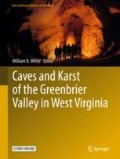Abstract
The Buckeye Creek watershed is a 14 km2 enclosed basin of which 12 km2 drains through Buckeye Creek Cave to lower Spring Creek. The 1.6-km long stream passage is generally 6+ meters wide and 3+ meters high with the primary restrictions being the Gray Canyon near the entrance and partially flooded sewer passages near cave’s downstream terminus. The passages below Turner Avenue are large trunks that are connected to the present stream passage by collapse features and solutional passages that may be remnant phreatic loops. Buckeye Creek grades to Spring Creek and the modern cave stream generally follows strike. The highest passages in Buckeye Creek Cave are at least 788,000 years old based on magnetic reversals found in cave sediments. Buckeye Creek Cave is being enlarged by corrosion, but abrasion and quarrying also play important roles. The abrasion is accomplished by sediment transported during floods. Three stalagmites were used to study local climates over the past 7,000 years. The most detailed time series record multiple dry periods lasting centuries. The “droughts” coincided with Bond Events, which were episodic periods of enhanced ice-rafting in the North Atlantic Ocean believed to have been triggered by protracted cooling.
Access this chapter
Tax calculation will be finalised at checkout
Purchases are for personal use only
References
Bond, G., B. Kromer, J. Beer, R. Muscheler, M.N. Evans, W. Showers, S. Hoffmann, R. Lotti-Bond, I. Hajdas, and G. Bonani. 2001. Persistent solar influence on North Atlantic climate during the Holocene. Science 294: 2130–2136. doi:10.1126/science.1065680.
Dasher, G., and W. Balfour, Eds. 1994. The Caves and Karst of the Buckeye Creek Basin, vol. 12. Barrickville, WV: West Virginia Speleological Survey Bulletin.
Fong, D.W., and D. Culver. 1994. Invertebrate fauna. In The Caves and Karst of the Buckeye Creek Basin Greenbrier County West Virginia, ed. G.R. Dasher and W.M. Balfour, vol. 12, 41–42. Maxwelton, WV: West Virginia Speleological Survey Bulletin.
Hardt, B., H.D. Rowe, G.S. Springer, H. Cheng, and R.L. Edwards. 2010. The seasonality of east central North American precipitation based on three coeval Holocene speleothems from southern West Virginia. Earth and Planetary Science Letters 295 (3–4): 342–348. doi:10.1016/j.epsl.2010.04.002.
McBride, K.A., and S.C. Sherwood (eds.). 2006. Report of archaeological investigations at [Unnamed Cave #14], West Virginia. Lexington, KY: Kentucky Archaeological Survey.
Schneider, K., and D. Culver. 2004. Estimating subterranean species richness using intensive sampling and rarefaction curves in a high density cave region in West Virginia. Journal of Cave and Karst Studies 66 (2): 39–45.
Springer, G.S. 2004. A pipe-based, first approach to modeling closed conduit flow in caves. Journal of Hydrology 289 (1–4): 178–189. doi:10.1016/j.jhydrol.2003.11.020.
Springer, G.S., and E.E. Wohl. 2002. Empirical and theoretical investigations of sculpted forms in Buckeye Creek Cave, West Virginia. The Journal of Geology 110 (4): 469–481. doi:10.1086/340442.
Springer, G.S., E.E. Wohl, J.A. Foster, and D.G. Boyer. 2003. Testing for reach-scale adjustments of hydraulic variables to soluble and insoluble strata: Buckeye Creek and Greenbrier River, West Virginia. Geomorphology 56 (1–2): 201–217. doi:10.1016/S0169-555X(03)00079-5.
Springer, G.S., H.D. Rowe, B. Hardt, R.L. Edwards, and H. Cheng. 2008. Solar forcing of Holocene droughts in a stalagmite record from West Virginia in east-central North America. Geophysical Research Letters 35: L17703. doi:10.1029/2008GL034971.
Springer, G.S., H.D. Rowe, B. Hardt, F.G. Cocina, R.L. Edwards, and H. Cheng. 2009. Climate driven changes in river channel morphology and base level during the Holocene and Late Pleistocene of Southeastern West Virginia. Journal of Cave and Karst Studies 71 (2): 121–129.
Springer, G.S., D.M. White, H.D. Rowe, B. Hardt, L.N. Mihimdukulasooriya, H. Cheng, and R.L. Edwards. 2010. Multiproxy evidence from caves of Native Americans altering the overlying landscape during the late Holocene of east-central North America. The Holocene 20 (2): 275–283. doi:10.1177/0959683609350395.
Springer, G.S., H.D. Rowe, B. Hardt, H. Cheng, and R.L. Edwards. 2014. East central North America climates during marine isotope stages 3–5. Geophysical Research Letters, p. 2014GL059884. doi:10.1002/2014GL059884.
Springer, G., H. Poston, B. Hardt, and H. Rowe. 2015. Groundwater lowering and stream incision rates in the Central Appalachian Mountains of West Virginia, USA. International Journal of Speleology 44 (1). http://dx.doi.org/10.5038/1827-806X.44.1.9.
Worthington, S. 1984. The Paleodrainage of an Appalachian Fluviokarst: Friars Hole, West Virginia, 218pp. MS Thesis, McMaster University. Hamilton, Ontario, Canada.
Author information
Authors and Affiliations
Corresponding author
Editor information
Editors and Affiliations
9.1 Electronic Supplementary Material
Below is the link to the electronic supplementary material.
Rights and permissions
Copyright information
© 2018 Springer International Publishing AG
About this chapter
Cite this chapter
Springer, G.S. (2018). Caves, Karst, and Science in the Buckeye Creek Cave Watershed. In: White, W. (eds) Caves and Karst of the Greenbrier Valley in West Virginia. Cave and Karst Systems of the World. Springer, Cham. https://doi.org/10.1007/978-3-319-65801-8_9
Download citation
DOI: https://doi.org/10.1007/978-3-319-65801-8_9
Published:
Publisher Name: Springer, Cham
Print ISBN: 978-3-319-65800-1
Online ISBN: 978-3-319-65801-8
eBook Packages: Earth and Environmental ScienceEarth and Environmental Science (R0)

